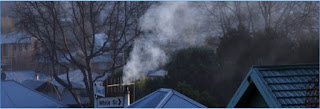CONA is back!
The 2015 CONA first pilot study in Rangiora is over.
But CONA is back! The second pilot study, also in Rangiora, is about to get underway.
The blog may have been quiet over the last 6 months, but we've ben beavering away, making sense of the mountain of data we collected. We've just released data to our 15 volunteer participants, telling them what we measured in their homes and found out about their woodburner use and indoor air quality. We've just put out a press release: https://www.niwa.co.nz/news/air-quality-scientists-look-for-smoke-signals and are putting the finishing touches to a technical report.
In brief we were very happy with the results of the pilot study. We found that our new technology sensors, the PACMAN for indoors and ODIN for outdoors, were not totally reliable, but when they worked they worked really well. Using an online survey to recruit participants and get them to report their perceptions of air quality was very easy and fairly reliable. Using small inobtrusive temperature sensors was an excellent way of monitoring when people were lighting their fires. And, by placing meteorological instrumentation around the edges of the town, we were able to observe that peaks in airborne particle concentrations were strongly influenced by changes in wind direction that often occur in the early evening.
All in all, we learned enough to believe that the CONA concept is a winner.
So what now? Well, now we're on our way back. The PACMAN and ODIN devices are getting sensor upgrade using new dust sensors which initial lab tests suggest are much more reliable and accurate. We're returning to some of our volunteer homes. Last year we found out how much indoor and outdoor emissions are contributing to indoor air quality. This year we will seek to establish why - what the sources are, and why it varies between homes.
Outdoors we'll be running woodburner and meteorological observations for a longer period (we only did a month last year), and we'll be testing over 20 ODINs compared to last year's 6.
As the project progresses we hope to hold a local information meeting, and may be recruiting further volunteers.
And as activities ramp up we'll do our best to keep the blog updated as often as we can.
But CONA is back! The second pilot study, also in Rangiora, is about to get underway.
The blog may have been quiet over the last 6 months, but we've ben beavering away, making sense of the mountain of data we collected. We've just released data to our 15 volunteer participants, telling them what we measured in their homes and found out about their woodburner use and indoor air quality. We've just put out a press release: https://www.niwa.co.nz/news/air-quality-scientists-look-for-smoke-signals and are putting the finishing touches to a technical report.
In brief we were very happy with the results of the pilot study. We found that our new technology sensors, the PACMAN for indoors and ODIN for outdoors, were not totally reliable, but when they worked they worked really well. Using an online survey to recruit participants and get them to report their perceptions of air quality was very easy and fairly reliable. Using small inobtrusive temperature sensors was an excellent way of monitoring when people were lighting their fires. And, by placing meteorological instrumentation around the edges of the town, we were able to observe that peaks in airborne particle concentrations were strongly influenced by changes in wind direction that often occur in the early evening.
All in all, we learned enough to believe that the CONA concept is a winner.
So what now? Well, now we're on our way back. The PACMAN and ODIN devices are getting sensor upgrade using new dust sensors which initial lab tests suggest are much more reliable and accurate. We're returning to some of our volunteer homes. Last year we found out how much indoor and outdoor emissions are contributing to indoor air quality. This year we will seek to establish why - what the sources are, and why it varies between homes.
Outdoors we'll be running woodburner and meteorological observations for a longer period (we only did a month last year), and we'll be testing over 20 ODINs compared to last year's 6.
As the project progresses we hope to hold a local information meeting, and may be recruiting further volunteers.
And as activities ramp up we'll do our best to keep the blog updated as often as we can.

Comments
Post a Comment